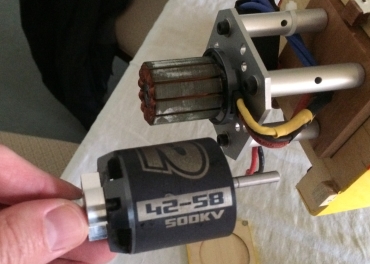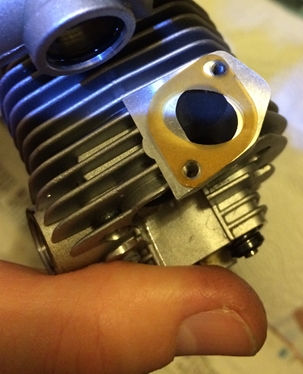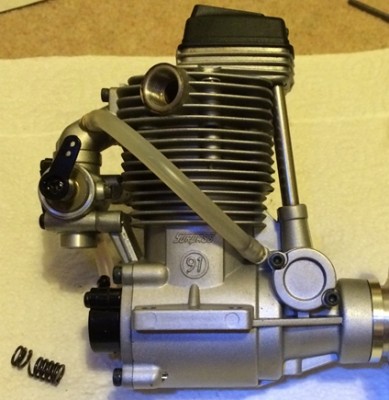
Buying an airframe from HobbyKing can be real hit and miss affair so I thought it worth writing about my experience.
Here are the specs as stated by HobbyKing:
Wingspan: 1612mm (Just over 63”)
Length: 1403mm
Dry Weight: 1672g
Flying Weight: 2350g (Just over 5lb. Hmmm…really? try 3Kg – 6.5lb)
Price £103.22
It can be powered by a 0.70 glow engine or 50mm Brushless Outrunner Motor.
Full details here:
http://www.hobbyking.com/hobbyking/store/__26002__Zlin_Z_50L_1612mm_0_70_class_Glow_EP_Sport_Scale_ARF_UK_Warehouse_.html?strSearch=zlin
When the kit arrived the overall fit and finish looked great. However, I did quickly noticed that the covering lifted easily at quite a few places on the edges. Still, I thought the iron would take care of that.
My original plan was to install an electric setup in this plane. I already had a suitable motor and speed controller. I changed this to IC when I hit a second snag. I’ll detail this in a moment, just a few comments on the build first.
Construction is fairly straightforward. The wing has a subtle dihedral and has to be permanently joined into a one-piece wing. The only possible pitfall I can see here is getting the dihedral brace the wrong way up.
All control surfaces use the fabric like hinges that soak up the CA. The slots are nicely pre-cut and it all goes together sweetly. There’s a ton of movement available on every surface ant they are all quite large too.
The aileron servos are mounted on the inside of panels that are then screwed to the wings. I like this arrangement because it is very neat. It did cause me a slight headache because the arms supplied with the standard servos (these) I was using throughout the plane were too short.
I bought a pair of alloy arms (these) and then file down the thickness so that it would fit through the slot. After the first flight, I moved the linkage to the inner one of the two holes in the servo arm. This still gives huge aileron throws and the plane is very lively on full rates.
The fuselage all went together very nicely all tail parts were nice and square, the canopy, cowl and wing-fuselage fit are all excellent. Rudder is pull-pull and elevator is on a single long pushrod (elevator halves are joined by a ‘U’ shaped wire.). So all servos are up front. The exit holes for all the control linkages are very neat and preserve the lines of the plane.
The problems started when I got to the power plant side of things. I had intended to use my NTM 42-58 motor (another HobbyKing purchase from a while back). I also had suitable batteries – 6s 4000mah.
I temporarily screwed the motor in place and put a battery in to see if the C of G would be OK. It wasn’t. It was about 50mm behind the target 118mm from the leading edge.
I put a heavy metal spinner on the nose, then I placed a 6s 2800mah battery on top of the 4000mah one.
Now the C of G was about 20mm behind the target position and the all-up-weight was getting high.
At first, I didn’t know what to do. How was I going to achieve the correct C of G without ending up with a 4Kg plane? Then I remembered that I had a new ASP 65 four stroke (bought at a Firebirds auction for £35). The reason I hadn’t installed it anywhere was because it’s not a great motor. It’s a 90 sized crankcase effectively under-bored with a 65 piston liner setup. This made the motor heavy for its power output.
I thought maybe this was a good candidate for the Zlin. The advantage (in this case) of I/C power is that all the weight in concentrated right up front in the engine, rather than mostly in the battery, which sits further back in the fuel tank area.
So I headed down the ASP 65 route. I mounted the engine horizontally and the room in the cowl was such that the rocker cover only just pokes out the side. The exhaust is fully contained and needed a silicone extension to get the exhaust snot outside the plane. The main needle pokes out the top and needs to be removed to get the cowl off.

Oh yeah, I also mounted the engine and cowl as far forward as possible. Such that the cowl doesn’t quite meet the fuselage at the bottom.
Despite the four stroke iron mongery up front, I still needed a lot of extra weight to balance the plane. I discovered that a 2S 4000mah LiPo (sibling of the one that exploded a while back) provided the necessary weight as long as it was fitted within the cowl. I also fitted a nice shiny aluminium spinner because that weighed 125g.
Finally! The C of G was achieved, although lifting the plane into the car was a challenge.
Guess what? The first flight revealed that the plane was very nose heavy. The spinner was swapped out for a plastic one, saving about 95g. Still nose heavy. The 4000mah LiPo was swapped for a 2000mah LiPo (saving about 100g), still nose heavy. It’s beginning to look like I could have had the setup I originally wanted now. Grrrrrr…..
I currently have the C of G set at 138mm from the leading edge. From the way it handles now, I reckon it could go back at least another 5mm or so.
Currently, loops, rolls, stall turns are fine. The knife edge requires quite a bit of work though. I have to hold a lot of up elevator and in one direction, I have to fight the plane’s desire to roll to inverted. I cannot get it to spin at all on rudder/evelator only.
At 3Kg, the all up weight is substantially higher than the advertised flying weight. However, 3Kg is a very reasonable weight for a plane this size and the low speed handling is superb, ‘floaty’ in fact.
In conclusion, I’m fairly happy with the Zlin. With it’s £3 servos, £35 engine and £103 airframe, it has been a cheap plane to build and flies well enough to keep me amused.

PS: I snapped off the undercarriage on a rough landing and it has been broken off twice since then, on much less harsh landings. The problem is not the vertically delivered shock of a hard landing, it’s the horizontal forces ripping the wheels backwards (say when you run into the long grass at the end of the strip). The rigid aluminium undercarriage transmits all the shock to the woodwork, which is way to flimsy to deal with it.
I have now fitted the exact same undercarriage arrangement that you get in a typical trainer, i.e. a torque wire arrangement that allows the wheels to be flexed upward and backward without tearing the arse out of your model.



















